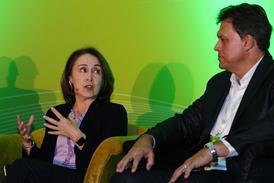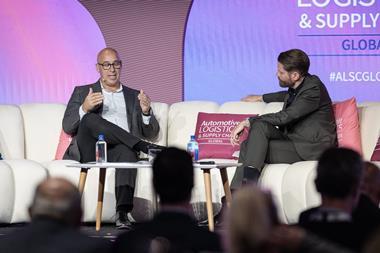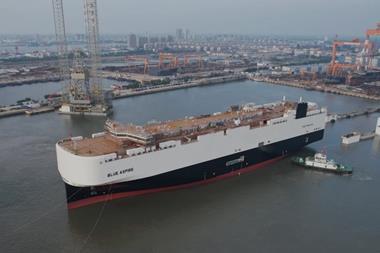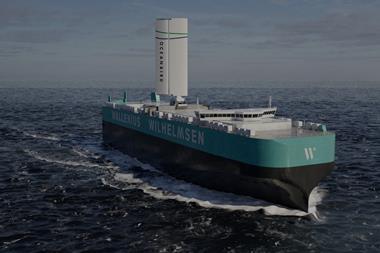Turkey faces some difficult economic headwinds that have already impacted on its automotive industry. But there are still several reasons for optimism, especially the country’s strength as a vehicle export hub with easy access to the European market
 As the fortunes of the logistics industry rise and fall with the automotive sector it serves, Turkey looks on the face of it to be a gloomy place to do business right now.
As the fortunes of the logistics industry rise and fall with the automotive sector it serves, Turkey looks on the face of it to be a gloomy place to do business right now.
The country’s economic crisis and the resulting slide in the value of the Turkish lira are having a devastating effect on the automotive market there. Sales of cars and light commercials fell 35% last year, from almost 1m units the year before, and the bad news has accelerated into 2019 with the market down a massive 59% in January, according to the Automotive Distributors’ Association (ODD).
If that was not bad enough, Honda announced in February that in 2021 it would close its plant in Izmit, where it currently makes the Civic sedan. The move will coincide with its complete exit from automotive production in Europe, including the closure of its UK factory in Swindon.
The collapse in the lira’s value last year rocketed the cost of imported cars, which account for around 60% of the market. Locally made cars have not escaped either, as interest rates have almost doubled to 32%, leaving the credit that drives Turkish car purchases unaffordable to many. Some manufacturers, like Toyota, buy their parts in euros too, meaning even locally made parts cannot offset the rise in cost of imported parts.
For delivery firms such as ANT Logistics, the effect is not just a drop-off in business. The credit crunch also cuts off access to new finance at manageable rates. “Because the cost of credit increased, it became almost impossible for automotive logistics companies to make any new investments,” says Ceren Eker Guven, deputy general manager for ANT Logistics.
In response, the government cut tax on new car purchases to stimulate sales, something that has been extended into the first quarter of 2019, but this has been criticised for being too restrictive on the type of cars to which it applies. “Another incentive with a broader scope might have better results,” Eker Guven says.
Analyst LMC Automotive predicts that the local market will almost halve in 2019, giving a forecast of just 443,000 unit sales. “Although, if the tax cuts are extended, we will adjust that forecast upwards,” says LMC analyst Carol Thomas.
LMC warns that OEMs facing the biggest challenges are those most exposed to the local market, such as Fiat Tofas, which saw production drop from 384,174 in 2017 to just over 300,000 last year. The Fiat Egea model is the bestselling car in Turkey. Ford Otosan, on the other hand, actually grew production slightly to 373,702 last year, overtaking Fiat to become the country’s biggest vehicle-maker, thanks in part to a relatively low exposure to the Turkish market.
Vital export hub
Ford’s performance shows that Turkey is worth far more to manufacturers than just its local market. The country has grown into a vital export hub for vehicle-makers wanting a low-cost manufacturing base with easy access to the key European market.
Last year, automotive manufacturers such as Ford Otosan, Fiat Tofas, Toyota, Oyak-Renault and Hyundai built 1.59m vehicles in Turkey. This was down from a record 1.75m the year before, but still the second-largest figure for the country. Just over 1m of those were cars, with light commercials accounting for just under 430,000, largely from Ford’s vast van factory complex in Kocaeli, on the coast of the Sea of Marmara. Factory capacity utilisation was still running at a healthy 78%, according to figures from Turkey’s Automotive Manufacturers’ Association (OSD).
Last year, automotive manufacturers such as Ford Otosan, Fiat Tofas, Toyota, Oyak-Renault and Hyundai built 1.59m vehicles in Turkey. This was down from a record 1.75m the year before, but still the second-largest figure for the country. Just over 1m of those were cars, with light commercials accounting for just under 430,000, largely from Ford’s vast van factory complex in Kocaeli, on the coast of the Sea of Marmara. Factory capacity utilisation was still running at a healthy 78%, according to figures from Turkey’s Automotive Manufacturers’ Association (OSD).
Exports accounted for 1.33m of the 1.59m units built, or 83%, making Turkey the country with the highest rate of automotive exports relative to total production, according to figures from Jato Dynamics, beating Canada at 82%.
The largest customer for exports by far was the EU, which took 85%. This makes Turkey the single largest supplier of vehicles to the EU, totalling almost 1m vehicles in 2017, according to the latest figures published by Europe’s automotive manufacturer association, ACEA. That was almost twice the amount exported to the EU by Japan, the second-largest supplier of vehicles to the EU based on 2017 figures.
The top vehicle exporter in 2018 was Ford Otosan with 328,502 units, followed by Oyak-Renault with 280,411 and Fiat Tofas with 243,796, according to OSD.
Turkey’s parts exports are also buoyant. Parts worth $1.4 billion left the country in 2018, up from $1.2 billion in 2017, according to OSD figures. The biggest parts supplier operating in Turkey is Bosch, with revenue of $901m in 2016, largely derived from locally produced brake systems, according to figures published by the country’s investment agency. Second was local tyre-maker Brisa, which makes Bridgestone tyres under licence, and third was wheel-maker CMS. Also in the top ten were Japanese electrical component manufacturer Yazaki, tyre-maker Goodyear and airbag specialist Autoliv.
Despite the financial setbacks, exports will rise slightly this year, predicts the local Automotive Industry Exporters’ Association (OIB). “We are aiming to overcome all difficulties and to close this year with an increase,” CEO Baran Çelik said in a statement.
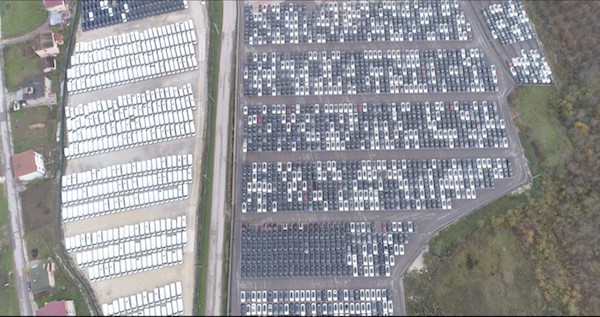 Investment doubts
Investment doubts
The big question is whether the country’s financial difficulties are going to deter automotive investment. OSD figures show that investment numbers have been falling since a high of $1.37 billion in 2014. They reached a low of $776m in 2017 but actually ticked higher last year at $871m. Much of that increase came from capacity development at $130m, compared with $80m in 2017, as well as a $25m increase in localisation.
Those of a gloomy disposition might feel tempted to suggest that Honda’s decision to shut its plant was the canary in the coalmine for Turkish manufacturing, but Honda said Turkey’s current economic problems were not the reason for the decision to pull out. And the OEM’s operation in Izmit is fairly small anyway, having made 38,319 Civic sedans last year, largely for the local market.
On the contrary, there is good reason for optimism over a possible increase in Turkish automotive capacity in the coming years. “I think political uncertainty, and where this will take the economy, is the biggest risk, but it looks at the moment as if OEMs that are already present are going to stick with Turkey,” says LMC’s Thomas.
Renault recently announced that it was going to make its Bursa plant a key location for European production of the new Clio compact car, while Hyundai is planning new investment in its Izmit, Kocaeli, factory to add new models to the i10 and i20 small cars it currently builds for Europe. A new small SUV joins the line-up in 2021, as well as a new sedan (probably a small one for the local market). That should boost capacity to over 245,000 and more than make up for Honda’s exit.
Perhaps the biggest news, however, came earlier this year when Ford announced a van partnership with VW that would see it build a medium-sized van for the German OEM alongside its own Transit. It was strongly hinted at, during the joint press conference, that this would take place in Ford’s Kocaeli plant complex, starting in 2023, which would surely mean capacity increases for the plant. The Kocaeli complex includes the Gölcük facility that makes the large Transit and the mid-size Transit Custom, and the Yeniköy plant that makes the small Transit Courier.
Of course, such plans could always be disrupted by forces outside the industry’s control. Turkey’s important trading relationship with the UK, for example, has faced several uncertainties in recent times as a result of the lack of clarity surrounding the latter’s exit from the EU (see box). Internal market fluctuations could also force OEMs to rethink plans.
But such challenges are just a part of doing business globally, reckons logistics firm Gefco, which is owned by Russian Railways and Groupe PSA. “We are used to such crises,” CEO Luc Nadal told the Turkish business publication Dunya Executive in October last year. For him, the economic downturn in Turkey is not cause for too much concern. “We are aware of the crisis in Turkey but we still trust in the Turkish economy,” he said. “The crisis will affect our industry, however it also offers opportunities and we will continue our investments.”
Gefco reckons it took 21% of the finished vehicle logistics market in Turkey in 2017, or 360,000 units.
The lack of debt attached to the firm’s Turkish operations gives it room to acquire new companies, says Nadal, singling out freight forwarding businesses as a good example. It also plans to open a new warehouse in Bursa, home of Fiat, this year. Gefco uses Turkey as a base for operations into the local region and says it plans to open new markets in North Africa and Saudi Arabia.
Infrastructure issues
What the economic crisis does do, however, is threaten to slow improvements to the infrastructure that logistics firms rely on to give the service that vehicle manufacturers and part suppliers demand.
“While the volume of exports from some Turkish ports has increased in recent years, Turkey is still lagging behind its European and regional competitors,” said Haydar Yenigün, chairman of the board of directors of the OSD, in January.
Most exports rely on Turkey’s seaports, mainly the 15 in the Marmara region, including Istanbul, and they are not up to standard. Yenigün said: “Although there are enough ports, infrastructure problems and their geographical locations can mean that capacity utilisation remains relatively low.”
 Single-access gates, which create bottlenecks for finished vehicles, are one example, he said, while some ports also lack appropriate parking areas for pre-delivery inspection, again slowing down the process, and others do not have adequate rail infrastructure.
Single-access gates, which create bottlenecks for finished vehicles, are one example, he said, while some ports also lack appropriate parking areas for pre-delivery inspection, again slowing down the process, and others do not have adequate rail infrastructure.
“Insufficient rail connections to ports and manufacturing plants are one of the factors hindering the development of Turkey’s intermodal transport,” he said, stressing that only six of the 15 Marmara region ports had rail connections.
In total, Turkey has 178 ports suitable for international shipping in the Sea of Marmara, the Black Sea and the Mediterranean coast, although those suitable for automotive logistics are far fewer. Only two of Turkey’s international ports are now state-owned after a 2004 act that allowed six of the biggest – Iskenderun, Derince, Bandırma, Izmir, Samsun and Mersin – to be privatised.
Yarimca port, in the Kocaeli region – home to Ford, Honda and Toyota – is one receiving a slug of investment totalling $110m from Turkish conglomerate Oyak (Renault’s partner) and Japanese shipping and logistics company NYK for a finished vehicle terminal. Expected to be operational this year, the so-called Oyak Port will have initial annual capacity for 780,000 vehicles and includes storage for 8,000. The owners reckon it will become the first large terminal near Istanbul dedicated to finished vehicles.
They can probably cross Ford off as a customer, however. Its waterside Kocaeli plant has its own deep-water pier that stretches out far enough to dock two ro-ro car carriers of up to 35,000 tonnes dead weight. Ford reckons its port handles 95-98% of its exports, making it the second largest for vehicles.
Trucking troubles
Many parts exports head into Europe by truck from Turkey’s border with Bulgaria, but despite the customs union with the EU it is not an easy process getting across the border. The UK’s Financial Times spoke to truckers waiting at the Kapikule crossing for a 2017 story investigating the practicalities for European countries outside the EU and found some drivers waiting 14 hours to cross, with queues stretching back 7-17km.
The customs union means that no duties are applied at the borders, but there are plenty of other documents to process – drivers need to show export declarations, Turkish customs carnets, invoices for the goods inside the truck, and a transport permit for all the EU countries they are going to be driving through. The FT quoted a 2015 study estimating the cost of all this border friction at around €3 billion ($3.4 billion) a year.
Among the uncertainties Turkey’s automotive sector has been facing recently has been the potential impact on its trade with the UK of the latter’s exit from the EU – the precise terms of which have been unclear for many months.
Turkey’s automotive sector is heavily dependent on the UK, which took in 12% of its automotive exports in 2017, valued at $2.25 billion, according to OSD. Two-thirds of those exports were Ford Transits. Such exports would fall by around a third, were the UK to leave the EU without any deal being in place, the OSD warns.
Turkey exports into the EU tariff-free via a customs union set up in 1996 and provides a mostly frictionless system (at least by sea, although land is a bit different), and this could be thrown into disarray without an orderly Brexit deal. The two countries would no longer have duty-free access. And vehicle sales would still suffer even if there were an agreement between the UK and the EU, if there were not also one between the UK and Turkey, the OSD says.
There’s also an issue the other way. The UK builds 36% of engines for Turkish production, largely diesel engines for the Ford Transit, and this too, could be dramatically affected by any change that threatened a reduction in frictionless trade and/or tariffs.
The issue is holding back Turkey’s parts and parts logistics industry, says Bogna Blasiak, corporate communications manager for logistics company Ekol Europe. “The two biggest problems for parts suppliers are the economic instability in the country and transport times,” he says.
The combination of the two means that vehicle-makers are reluctant to rely any more on Turkish parts supply, despite the cost advantages. “The expectation of the OEMs is to get parts supplies in one to two days at the latest. But it is around five to six days at the earliest from Turkey,” Blasiak states.
Even getting to the border can be difficult. The OSD’s Yenigün believes that Turkey requires better links between its European and Asian sides (split by the Sea of Marmara), including a possible sea tunnel at the sea’s narrowest point.
Such improvements require long-term help from a government that currently has its hands full managing an economic crisis (albeit one of its own making, some commentators suggest). In the meantime, logistics firms like ANT Logistics are improving their service by integrating more closely with the vehicle-makers.
“The logistics service provider’s job is not only to provide the transport but also to optimise the logistics flows of the OEMs,” says Eker Guven of ANT Logistics. The company, which operates 100 vehicle transporters within Turkey, says it offers its customers the ability to track deliveries in real time via an IT system that synchronises with that of the manufacturer.
“They can track their own KPIs via our platforms, which assists the OEMs in improving their sales and planning capabilities,” Eker Guven explains.
Looking ahead, the consensus among logistics firms seems to be that, while Turkey’s economic problems are bad, they are not crippling to the overall growth trend for its automotive business.
As Gefco’s Luc Nadal puts it: “In 2019, there will be strong storms and winds. Despite all these adversities, we trust in Turkey.”








